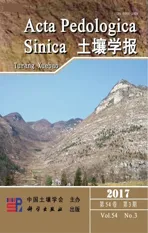不同有机物料对微域内土壤原生动物和线虫的影响*
2017-06-07蔡冰杰范文卿王慧刘满强于建光刘婷李辉信陈小云
蔡冰杰范文卿王 慧刘满强于建光刘 婷李辉信陈小云†
(1 南京农业大学资源与环境科学学院,南京 210095)
(2 江苏省农业科学院农业资源与环境研究所,南京 210014)
不同有机物料对微域内土壤原生动物和线虫的影响*
蔡冰杰1范文卿1王 慧1刘满强1于建光2刘 婷1李辉信1陈小云1†
(1 南京农业大学资源与环境科学学院,南京 210095)
(2 江苏省农业科学院农业资源与环境研究所,南京 210014)
施用有机物料能够显著影响土壤肥力和生物群落结构,然而有机物料在土壤中分布不均会加剧土壤空间异质性,进而对土壤生物群落的结构和功能产生进一步的影响。选用水稻秸秆和白三叶草两类有机物料,按比例混合后装于网袋,置于预先装好土的培养容器中恒温培养,在培养的第14、35和70天分别对其中的不同微域(0~1 cm和1~5 cm)土样进行采集,分析其中的土壤原生动物和线虫群落结构的变化。结果表明,有机物料种类及培养时间对原生动物和线虫数量的影响更大,采样微域对二者的影响相对较小。水稻秸秆添加下的土壤植食性线虫、食真菌线虫和捕杂食线虫数量显著高于白三叶草添加;而白三叶草添加下的土壤变形虫、鞭毛虫和线虫总数、食细菌线虫数量显著高于水稻秸秆添加。从整个培养周期来看,鞭毛虫数量随培养时间的延长逐渐减少,而变形虫和线虫总数则随培养时间的延长逐渐增多。在同一有机物料下不同微域间土壤原生动物和线虫在培养初期会出现一定的数量差异,但这种差异随培养时间的延长逐渐消失。
有机物料; 微域; 线虫;原生动物
有机物料作为提高农田土壤有机质水平的主要来源途径,是改善土壤理化性质、优化土壤生物群落结构、综合提高土壤地力和生态功能的关键调控因子[1-4]。因此加强有机物料的综合利用,是推进农业可持续发展的必要途径。在实际应用中,有机物料施入到土壤后很难以一种充分混匀的理想状态分布,而是会集中分布于某些区域,从而导致这些区域附近积累更多的有机碳等养分成为一个特殊的微环境。在这一微域内,有机物料分解区域的营养成分浓度高于整个土体数倍甚至十几倍[5-6]。许多研究将这种在土壤中分布不均、养分有效性高于周围土体的斑块称之为“营养斑(Nutrient patch)”。由于碳氮等养分资源集中,使得微生物和以微生物为食物来源的其他土壤生物大量繁殖,从而导致这一微域的生物活性极高[7-9]。目前,已有大量报道证实了高活性微域对土壤生态系统结构和功能的维持具有重要作用[10-12]。
土壤微生物在有机物料分解和养分转化过程中起着决定性作用。作为土壤微生物的主要取食者,原生动物和线虫两类微型土壤动物对有机物料的响应较其他土壤动物更为敏感[13-14]。在施入有机物料的土壤中,原生动物和自由生活线虫(主要为食细菌线虫和食真菌线虫)能够有效地调控土壤微生物群落的数量和结构,促进碳氮的转化过程[15]。Briar等[16]研究土壤团聚体中的土壤生物群落,发现小尺度上(200~1 000 μm)土壤微生物和线虫群落均受制于资源有效性,线虫对生境空间的依赖性更明显。此外,原生动物和线虫对碳氮矿化的贡献还依赖于有机物料的质量,例如,一般低质量或高碳氮比(C∶N大于30)的有机物能引起土壤生物对氮素的生物固定[17]。
为进一步了解土壤活性微域内的生物群落结构与功能,本研究选用水稻秸秆和白三叶草两类常见有机物料,动态监测两类有机物料分解过程中离有机物料较近微域(0~1 cm)及较远微域(1~5 cm)的微型土壤动物(原生动物和线虫)的数量变化,旨在为了解土壤碳氮转化过程的生物贡献机制提供理论基础。
1 材料与方法
1.1 供试材料
供试土壤采自江苏南通长江冲积物形成的潮土,土属为高沙土(Orthic aquisols),种植制度为稻麦轮作。土壤取样深度为0~20 cm,土样过2 mm筛并剔除大中型土壤动物及根茬等,室温黑暗预培养15 d。预培养后土壤的理化性质为总有机碳16.6 g kg-1,全氮0.8 g kg-1,碱解氮67.4 mg kg-1,有效磷42.8 mg kg-1,速效钾77.2 mg kg-1,pH 6.78,并将土壤含水量控制在田间持水量的65%。
试验选用水稻秸秆和白三叶草2种常见的有机物料,烘干后粉碎过0.25 mm筛备用。两种物料的基本性质如下:水稻秸秆有机碳 435.1 g kg-1,全氮 8.8 g kg-1,C/N 51,全磷 1.7 g kg-1,全钾14.3 g kg-1;白三叶草秸秆有机碳 312.5 g kg-1,全氮36.4 g kg-1,C/N 9,全磷 3.2 g kg-1,全钾 23.9 g kg-1。
1.2 试验设计
室内培养试验所用培养容器为高7 cm、长13 cm、宽10 cm的蜡盒(图1),将石蜡和凡士林按2∶1比例在水浴中熔化混匀后倒入模具浇铸而成[18]。在蜡盒内侧的底部和四周放置相应尺寸的PVC膜以隔绝蜡盒与土壤的接触。在蜡盒中间放置一挡板,将挡板左侧均匀装土564 g。按1%的比例分别添加水稻和白三叶草秸秆于网袋(11 cm× 7 cm,孔径1.5 mm)内,将网袋置于蜡盒中间替换挡板,再向网袋右侧装土564 g。最后将蜡盒用保鲜膜封口,以防水分散失。共设4组重复,黑暗恒温室内(25±1)℃培养,并在培养过程中第14、35、70天分别进行破坏性取样。
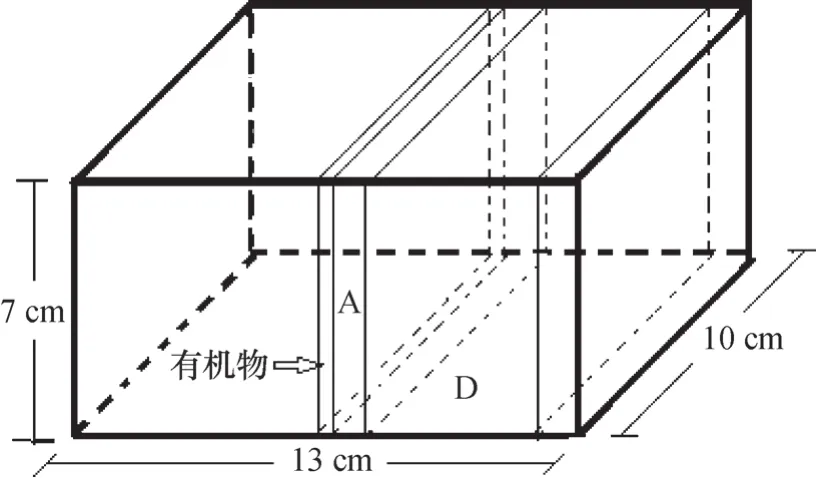
图1 有机物影响微域的培养装置示意图Fig.1 Schematic diagram of the experimental system
微域采样方法:容器边缘均去除1 cm宽的保护条带,用小刀将距离网袋1 cm的两侧土壤小心的割离下来,作为距离斑块近的微域A(0~1 cm);然后依次将距离网袋较远的土壤割离下来,作为距离斑块较远的微域D(1~5 cm)。将采集好的土壤混匀后置于4℃冰箱进行保存。
1.3 测定方法
对采集的土壤样品分别测定土壤可溶性有机碳(DOC)、可溶性有机氮(DON)、硝态氮NO3--N、基础呼吸、微生物生物量碳(M B C)和氮(MBN)、原生动物(鞭毛虫和变形虫)和线虫群落结构。
称取相当于10 g干土(105 ℃下24 h)的土壤,超纯水浸提(土液比1∶5)振荡1 h后在8 000 r min-1离心机中离心10 min,上清液过孔径0.45 μm的醋酸纤维素滤膜后利用TOC Multi N/C 3100仪测定DOC。另取上清液利用连续流动分析仪(Skalar Breda,荷兰)测定DON。土壤无机氮经2 mol L-1KCl溶液振荡30 min提取后过滤,利用流动分析仪测定滤液中的铵态氮和硝态氮含量。由于NH4+-N含量极低,处理之间无差异,因此未在结果内列出。土壤微生物生物量采用氯仿熏蒸-硫酸钾溶液浸提法,土壤微生物生物量碳氮的转换系数分别为KC=0.38、KN=0.54,分布计算MBC和MBN的含量。土壤有机碳矿化采用气相色谱(AGILENT,7890A,美国)在24 h内测定每次采集的气体样品。
土壤线虫采用浅盘法分离,称取50 g鲜土置于浅盘上的线虫滤纸上,加水至浸没土壤,在22 ℃下静置48 h后用500目筛分离线虫。在光学显微镜下计数(Motic,SMZ-168),在生物显微镜下(Motic,BA310)鉴定到属,并将线虫划分为不同c-p值和四大营养类群(植食性线虫、食细菌线虫、食真菌线虫和捕杂食线虫)。线虫生态指数的计算为[19]:(1)线虫通道指数(Nematode channel ratio,NCR):食细菌线虫和食微(食细菌+食真菌)线虫之比;(2)香农-威尔(Shannon-Wiener)多样性指数(H′):=-∑PilnPi,其中Pi为第i个分类单元中个体占线虫总数的比例;(3)成熟度指数(Maturity Index,MI):∑MI2-5 = Σvi×fi,其中vi为根据自由生活线虫不同生活史分别赋予的c-p值,fi为某一属(i)在自由生活线虫中所占的比例;(4)结构指数(Structure Index,SI):SI = 100×(s/(b + s)),b主要指食细菌和食真菌线虫中c-p值为2的类群,s为食细菌、食真菌和杂食性线虫中c-p值为3~5的类群以及捕食性线虫中c-p值为2~5的类群。
原生动物采用最大或然数法测定[20]。称取3 g鲜土加入到30 ml阿米巴缓冲液振荡20 min,吸取50 μl土壤悬液在加入100 μl 0.1% TSB 的96孔板中依次稀释,培养定期在倒置显微镜下记录原生动物的出现频率。
1.4 数据处理
采用重复测量方差分析有机物料、取样位置及采样时间三者的交互影响。文中的数据分析和作图分别采用SPSS 13.0和Origin软件;不同处理间的差异显著性采用Duncan法检验,如不特别注明,显著水平均指p<0.05,极显著差异指p<0.01。
2 结 果
2.1 有机物料对不同微域内土壤原生动物的影响
有机物料质量、采样位置及培养时间对原生动物的数量产生了一定的影响(表1)。随着培养时间的延长,施加不同有机物料的土壤中不同微域内变形虫的数量整体均呈现出上升趋势,但是并未形成微域间的显著差异(图2)。白三叶草对变形虫数量的增加效果较水稻秸秆明显,且在白三叶草作用下,离物料近的微域内变形虫数量较远距离微域内数量更多;而在施加水稻秸秆的土壤中,不同的微域之间未形成显著差异。鞭毛虫的变化趋势则与变形虫明显不同,施用两种有机物料施加均降低其数量,且离物料近的微域内鞭毛虫数量更多,但是这部分差异会随培养时间的延长逐渐变小。
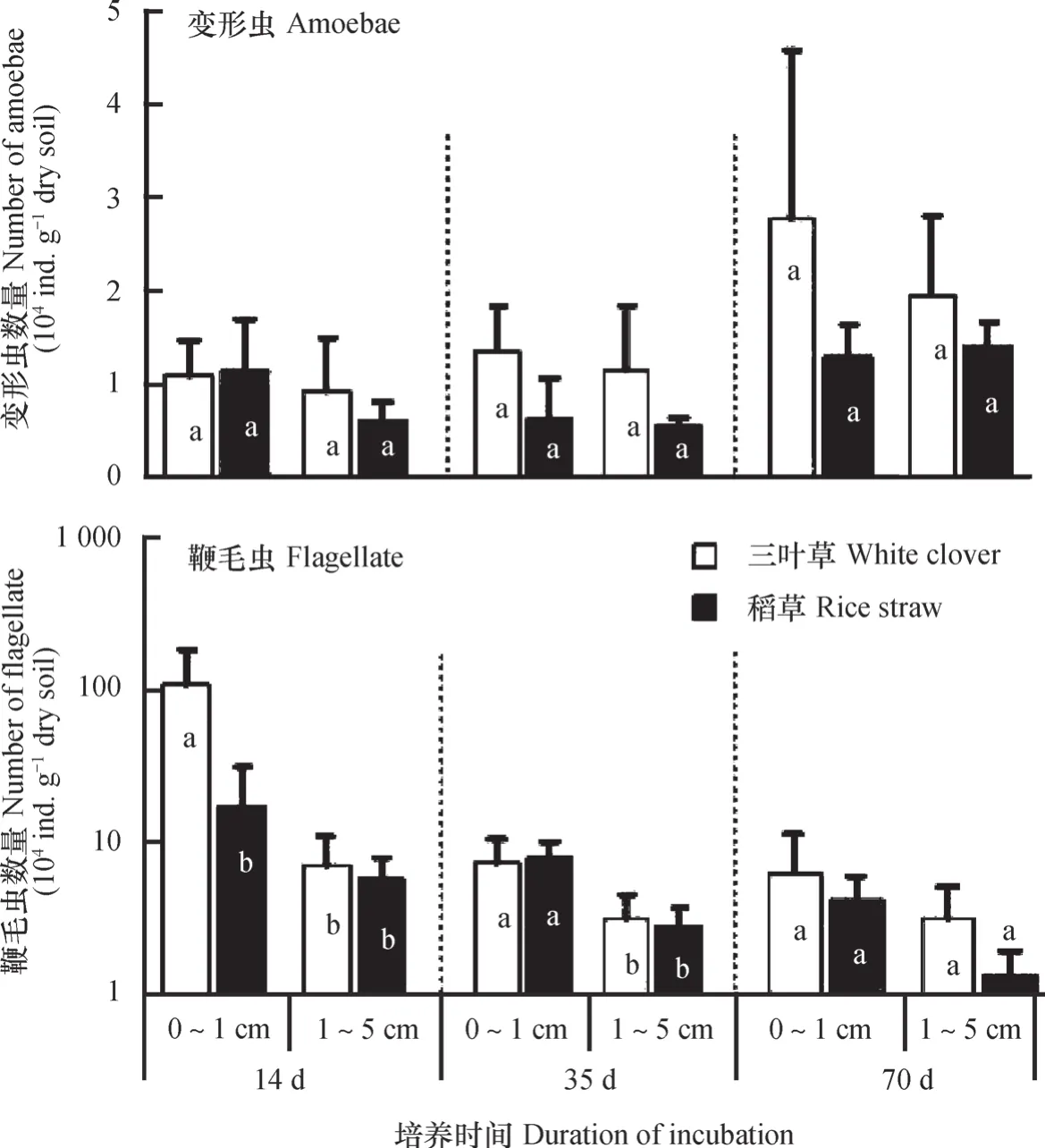
图2 不同培养时间下有机物料质量和取样位置对土壤变形虫和鞭毛虫数量的影响Fig. 2 Influence of organic residue and sampling site on number of amoebae and flagellate relative to duration of incubation
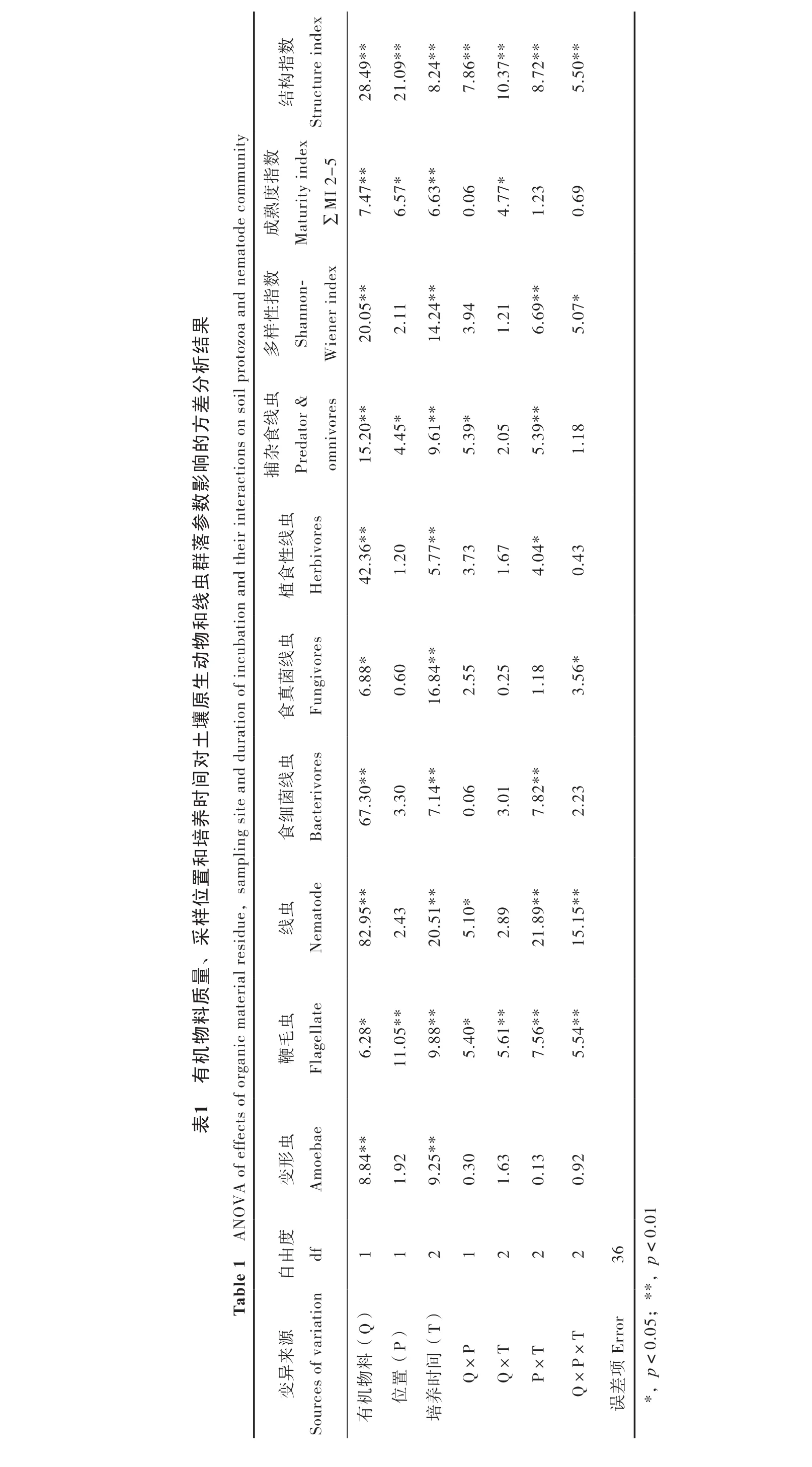
2.2 有机物料对不同微域内土壤线虫的影响
线虫数量的变化趋势相比原生动物更为复杂。随培养时间的延长,距水稻秸秆网袋的不同微域内的线虫数量呈上升趋势,而不同微域间线虫数量没有显著性差异(图3)。白三叶草对不同微域的影响则与水稻秸秆有很大的不同,培养14 d时,白三叶草网袋0~1 cm微域的线虫数量显著高于1~5 cm微域线虫数量;随着培养时间的延长,白三叶草网袋0~1 cm微域线虫数量逐渐减少,并显著低于1~5 cm微域。不同处理下,线虫多样性指数H′和成熟度指数∑MI2-5受有机物料质量和培养时间的影响更为显著(表1,p<0.05,图3)。白三叶草对线虫总量的促进作用明显高于稻草秸秆,且不同微域内食细菌线虫比例显著高于水稻秸秆,但是食真菌、植食、捕杂食线虫百分比、多样性指数H′、成熟度指数和结构指数均低于水稻秸秆处理。
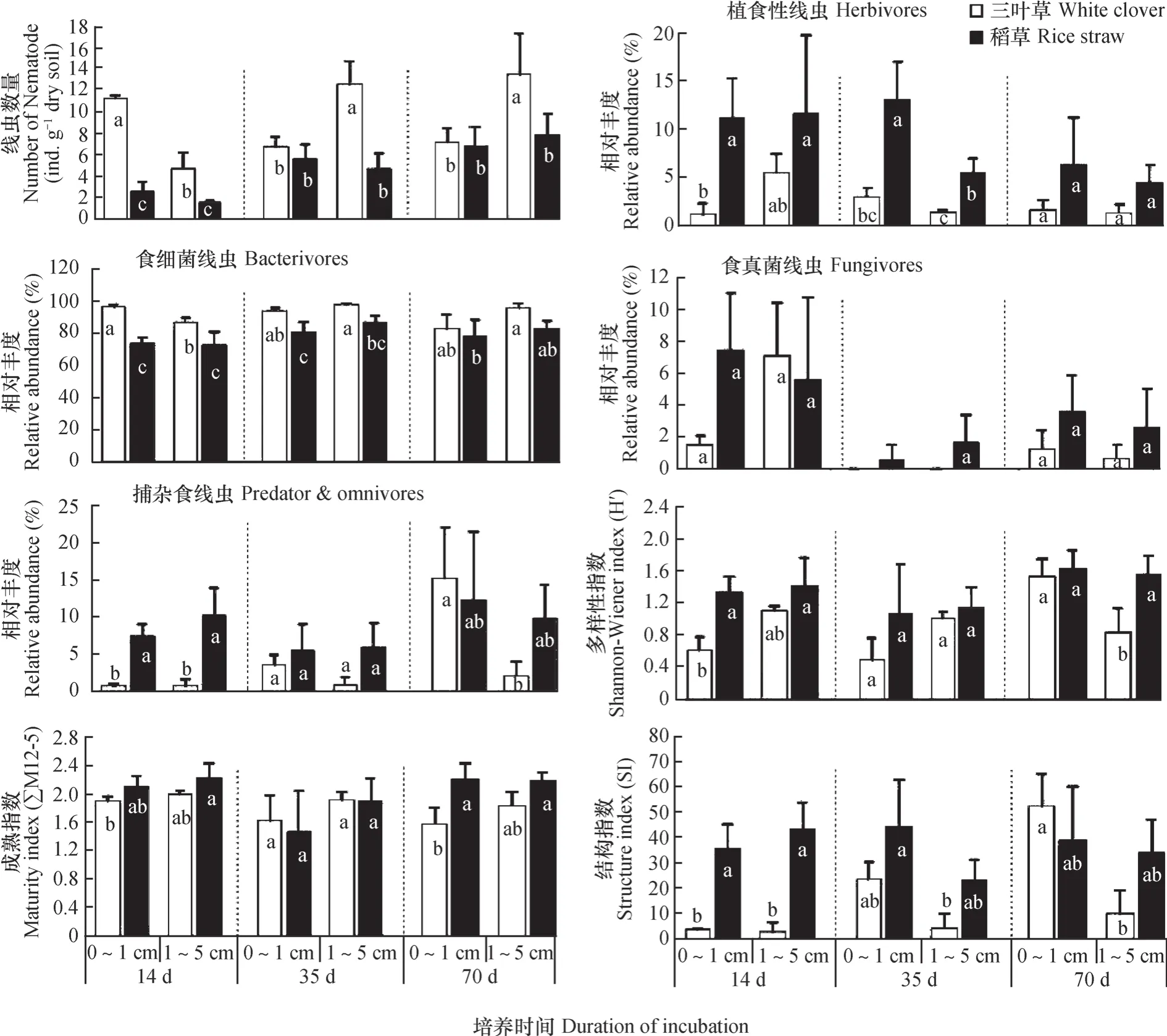
图3 不同培养时间下有机物料质量和采样位置对土壤线虫的影响Fig. 3 Influences of organic residue and sampling site on soil nematodes relative to duration of incubation
2.3 土壤原生动物、线虫与土壤性质的相关性
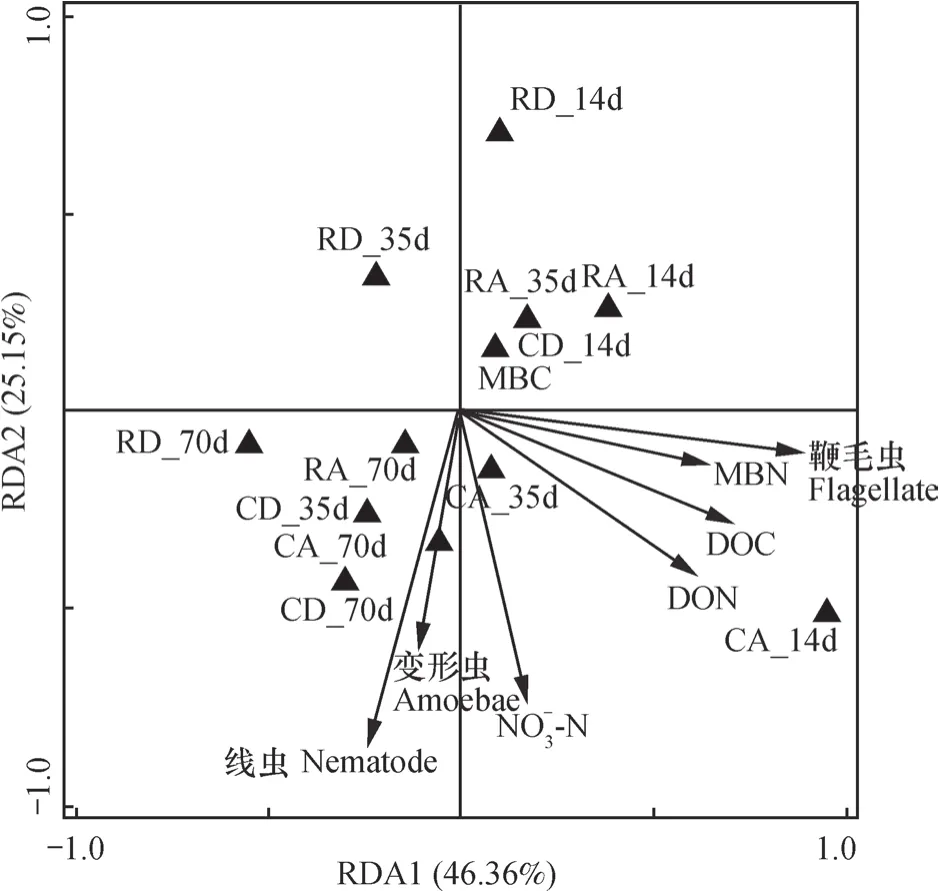
图4 土壤微动物、基本性质、微生物性质三者交互作用的RDA分析Fig. 4 Redundancy analysis of the interaction between soil microfauna,basic properties,microbial properties
土壤DOC、DON、NO3--N以及微生物性质均受到有机物料质量、取样位置、培养时间以及三者之间交互作用的显著影响,并进一步对土壤原生动物和线虫产生影响(图4)。培养的第14天,土壤DOC、DON、NO3--N以及MBC、MBN与离网袋0~1 cm的微域均呈正相关,有利于原生动物及线虫的繁殖。在培养后期,NO3--N与各微域间的正相关性加强最为明显,并进而促使变形虫和线虫整体数量的增加。而MBC、MBN则随着培养时间的延长,与各微域的相关性减弱,并在一定程度上促使鞭毛虫数量的减少。
3 讨 论
3.1 不同有机物料对土壤原生动物和线虫的影响
本研究结果可以看出,不同质量的有机物料对土壤活性碳氮和微生物性质的影响会延伸至土壤食物网内更高营养级微型动物上。然而两种原生动物(鞭毛虫和变形虫)对不同有机物料的添加响应并不强烈,其原因可能是在资源与空间有限的情况下,线虫对真菌和细菌的取食强度大于原生动物,从而抑制了原生动物的发展,这也与添加白三叶草的培养土中原生动物最终减少的结果相符。线虫对有机物料的响应趋势与原生动物不同,添加两类有机物料均能增加土壤线虫数量这与许多研究结果一致[21]。本试验中在白三叶草作用下,线虫快速繁殖,虽然不同微域和采样时间对其有一定影响,但整体上添加白三叶草的线虫总数显著高于水稻秸秆。而水稻秸秆拥有较高C/N,更有益于土壤环境的稳定性,因此对线虫中的食真菌者、植食者、捕杂食者和群落多样性和结构复杂性的指数(H′、∑MI 2-5和SI)有着更大的促进作用。这之间的差异可能与不同有机物料在土壤中的分解速度及产生的活性物质有关。低C/N的白三叶草能够更快分解进入土壤,活性有机物料能够迅速被附近的微生物同化,使得食细菌线虫对其迅速作出响应,成为新环境下的优势种群,继而导致了其他微生物种群相对数量的减少,造成培养初期微生物的结构及多样性更单一[22];而高C/N的有机物料的分解及输出则相对显得平缓,土壤微生物的响应也并不迅速剧烈,因此没有出现某一微生物种群的急剧增长,土壤中微食物网相对较平衡。需要注意的是,本试验中水稻秸秆的添加显著促进了植食线虫的数量和比例,这一结果与已有的一些研究相符[23];也有一些研究认为有机物料施入土壤可以抑制食植物线虫[14,24]。造成这些结论不同的原因可能是由于有机物料的差异,例如,有发现表明猪粪堆肥的添加会显著增加植食性线虫的数量,而秸秆的添加却会抑制植食性线虫的繁殖[21]。水稻秸秆的分解产物可能恰好能够在不破坏土壤微食物网的前提下被食植物线虫所利用,使得食植物线虫在培养期间获得了一定的增长。
3.2 不同微域对土壤原生动物和线虫的影响
虽然随培养时间的延长,不同微域间的差异会逐渐减小,但是在培养初期,不同的微域对土壤内的原生动物和线虫仍有显著的影响。其中,不同有机物料作用下的原生动物数量相对受微域距离远近的影响较小,这可能是由于原生动物主要摄取可溶性碳等溶解态营养物质[25],而培养箱内土壤中溶解态营养物质能够较快混合均匀;而白三叶草作用下0~1 cm微域内的线虫则明显多于1~5 cm微域内的线虫数量,这可能是因为低C/N的有机物料更易向土壤提供DOC和DON并且促进有机N的矿化,进而使得活性有机物料迅速被距其近的微域内的微生物快速同化,促进了线虫的繁殖。当该微域内线虫大量繁殖后,则会导致资源消耗过盛,为了获得更多的资源和空间进行更好地繁殖,线虫则需要向距网袋较远的微域进行迁移,使得较远的微域内线虫数量高于离有机物料近的微域。
4 结 论
有机物料施入到土壤造成微环境的高度异质性对土壤活性碳氮、微生物学性质以及微型动物的影响深刻。与高碳氮比的水稻相比,距网袋近的微域可溶性碳氮、NO3--N和微生物生物量更易受到低碳氮比的白三叶草的促进作用,从而进一步影响到微域内土壤微动物的变化。然而,原生动物可能由于其移动性有限,在不同微域间未出现显著性差异。不同微域内线虫在培养的初始阶段对不同质量的有机物料的响应不同。在培养初期,得到白三叶草释放的大量养分的距网袋近的微域内,微生物的增殖促进了线虫的发展,而随着资源的消耗和空间的有限性,线虫群落逐渐向外扩增,致使距网袋远的微域内的线虫得到进一步发展。
[1] 袁嫚嫚,刘勤,张少磊,等. 太湖地区稻田绿肥固氮量及绿肥还田对水稻产量和稻田土壤氮素特征的影响. 土壤学报,2011,48(4):797—803
Yuan M M,Liu Q,Zhang S L,et al. Effects of biological nitrogen fixation and plow-down of green manure crop on rice yield and soil nitrogen in paddy field(In Chinese). Acta Pedologica Sinica,2011,48 (4):797—803
[2] 马超,周静,刘满强,等. 秸秆促腐还田对土壤养分及活性有机碳的影响. 土壤学报,2013,50(5):915—921
Ma C,Zhou J,Liu M Q,et al. Effects of incorporation of pre-treated straws into field on soil nutrients and labile organic carbon in Shajiang black soil(In Chinese). Acta Pedologica Sinica,2013,50(5):915—921
[3] Turmel M S,Speratti A,Baudron F,et al. Crop residue management and soil health:A systems analysis. Agricultural Systems,2015,134:6—16
[4] 张红,吕家珑,曹莹菲,等. 不同植物秸秆腐解特性与土壤微生物功能多样性研究. 土壤学报,2014,51 (4):743—752
Zhang H,Lü J L,Cao Y F,et al. Decomposition characteristics of different plant straws and soil microbial functional diversity(In Chinese). Acta Pedologica Sinica,2014,51(4):743—752
[5] 鲁如坤. 微域土壤学——一个可能的土壤学的新分支.土壤学报,1999,36(2):287—288
Lu R K. Microzone soil science—A possible new branch of soil science(In Chinese). Acta Pedologica Sinica,1999,36(2):287—288
[6] Nicolardot B,Bouziri L,Bastian F,et al. A microcosm experiment to evaluate the influence of location and quality of plant residues on residue decomposition and genetic structure of soil microbial communities. Soil Biology & Biochemistry,2007,39(7):1631—1644
[7] Blaud A,Lerch T Z,Chevallier T,et al. Dynamics of bacterial communities in relation to soil aggregate formation during the decomposition of13C-labelled rice straw. Applied Soil Ecology,2012,53(1):1—9
[8] Peralta A L,Matthews J W,Flanagan D N,et al. Environmental factors at dissimilar spatial scales influence plant and microbial communities in restored wetlands. Wetlands,2012,32(6):1125—1134
[9] Gaillard V,Chenu C,Recous S. Carbon mineralisation in soil adjacent to plant residues of contrasting biochemical quality. Soil Biology & Biochemistry,2003,35(1):93—99
[10] 花莉,金素素,洛晶晶. 生物质炭输入对土壤微域特征及土壤腐殖质的作用效应研究. 生态环境学报,2012,21(11):1795—1799
Hua L,Jin S S,Luo J J. Effect of bio-char on the micro-environment characteristics and humus in soil (In Chinese). Ecology and Environmental Sciences,2012,21(11):1795—1799
[11] Xia S W,Chen J,Schaefer D,et al. Effect of topography and litterfall input on fine-scale patch consistency of soil chemical properties in a tropical rainforest. Plant and Soil,2016,404(1):385—398
[12] Koranda M,Schnecker J,Kaiser C,et al. Microbial processes and community composition in the rhizosphere of European beech —The influence of plant C exudates. Soil Biology & Biochemistry,2011,43(3):551—558
[13] 王芳,张金水,高鹏程,等. 不同有机物料培肥对渭北旱塬土壤微生物学特性及土壤肥力的影响. 植物营养与肥料学报,2011,17(3):702—709
Wang F,Zhang J S,Gao P C,et al. Effects of application of different organic materials on soil microbiological properties and soil fertility in Weibei rainfed highland(In Chinese). Plant Nutrition and Fertilizer Science,2011,17(3):702—709
[14] Tabarant P,Villenave C,Risede J M,et al. Effects of four organic amendments on banana parasitic nematodes and soil nematode communities. Applied Soil Ecology,2011,49:59—67
[15] Scharroba A,Dibbern D,Hünninghaus M,et al. Effects of resource availability and quality on the structure of the micro-food web of an arable soil across depth. Soil Biology & Biochemistry,2012,50:1—11
[16] Briar S S,Fonte S J,Park I S. The distribution of nematodes and soil microbial communities across soil aggregate fractions and farm management systems. Soil Biology & Biochemistry,2011,43(5):905—914
[17] Rousk J,Baath E. Fungal and bacterial growth in soil with plant materials of different C/N ratios. FEMS Microbiology Ecology,2007,62(3):258—267
[18] Khasawneh F E,Soileau J M. Soil preparation and sampling for studying ion movement. Soil Science Society of America Journal,1969,33(3):476—477
[19] 刘贝贝,叶成龙,虞丽,等. 不同植被类型的滩涂湿地土壤线虫群落特征. 应用生态学报,2012,23 (11):3057—3064
Liu B B,Ye C L,Yu L,et al. Characteristics of soil nematode communities in coastal wetlands with different vegetation types(In Chinese). Chinese Journal of Applied Ecology,2012,23(11):3057—3064
[20] 赵峰,徐奎栋. 土壤原生动物研究方法. 生态学杂志,2010,29(5):1028—1034
Zhao F,Xu K D. Methodological advances in soil protozoa research(In Chinese). Chinese Journal of Ecology,2010,29(5):1028—1034
[21] 刘婷,叶成龙,陈小云,等. 不同有机肥源及其与化肥配施对稻田土壤线虫群落结构的影响. 应用生态学报,2013,24(12):3508—3516
Liu T,Ye C L,Chen X Y,et al. Effects of different organic manure sources and their combinations with chemical fertilization on soil nematode community structure in a paddy field of East China(In Chinese). Chinese Journal of Applied Ecology,2013,24 (12):3508—3516
[22] 孔维栋,刘可星,廖宗文,等. 不同腐熟程度有机物料对土壤微生物群落功能多样性的影响. 生态学报,2005,25(9):2291—2296
Kong W D,Liu K X,Liao Z W,et al. Effects of organic matters on metabolic functional diversity of soil microbial community under pot incubation conditions (In Chinese). Acta Ecologica Sinica,2005,25 (9):2291—2296
[23] Liu T,Whalen J K,Shen Q R,et al. Increase in soil nematode abundance due to fertilization was consistent across moisture regimes in a paddy rice-upland wheat system. European Journal of Soil Biology,2016,72:21—26
[24] Hu C,Qi Y C. Effect of compost and chemical fertilizer on soil nematode community in a Chinese maize field. European Journal of Soil Biology,2010,46:230—236
[25] 陈小云,刘满强,胡锋,等. 根际微型土壤动物——原生动物和线虫的生态功能. 生态学报,2007,27 (8):3132—3143
Chen X Y,Liu M Q,Hu F,et al. Contributions of soil micro-fauna(protozoa and nematodes)to rhizosphere ecological functions(In Chinese). Acta Ecologica Sinica,2007,27(8):3132—3143
Effects of Organic Materials on Soil Protozoa and Nematodes in Microzones
CAI Bingjie1FAN Wenqing1WANG Hui1LIU Manqiang1YU Jianguang2LIU Ting1LI Huixin1CHEN Xiaoyun1†
(1 College of Resources and Environmental Sciences,Nanjing Agricultural University,Nanjing 210095,China)
(2 Institute of Agriculture Resources and Environment,Jiangsu Academy of Agricultural Sciences,Nanjing 210014,China)
【Objective】Application of organic manure or material may affect soil fertility and soil microbial community structure. However,uneven distribution of the organic materials applied in the soil may aggravate spatial heterogeneity of the soil,and hence affect structure and functions of the soil biota therein. To determine how much organic materials will affect spatial heterogeneity of the soil,an in-lab soil incubation experiment was conducted for observation of how soil protozoa and nematode community structure responded toorganic materials(rice straw and white clover)in different microzones(0~1 cm,1~5 cm).【Method】Rice straw or white clover was proportionally mixed up with soil and put into net bags separately. Then the bags were put into the vessels of the tested soil,separately,for incubation under a constant temperature (25±1℃)for 70 days. Soil samples were collected from microzones adjacent to(0~1 cm)and far apart (1~5 cm)from the net bags,on D14,D35 and D70 for analysis of abundance,Shannon-Wiener index (H′),structure index(SI)and maturity index(∑MI2-5)of nematodes,and soil dissolved organic carbon(DOC),dissolved organic nitrogen(DON),nitrate nitrogen(NO3--N),microbial biomass carbon(MBC)and nitrogen(MBN),as well,which may be related to changes in the microfauna in the soils amended with rice straw or clove.【Result】In this experiment,it was found that on the whole kind of the organic material and duration of incubation were the two major factors affecting the numbers of protozoa and nematodes,however,it does not mean that location of the microzone for sampling had no impact on soil microbes therein. Within the initial period of incubation(0~14 days),in microzones of the soil amended with the same organic material,the numbers of soil microbes in the adjacent microzones(0~1 cm)were higher than those in the far-apart microzones(1~5 cm),which is more obvious in the soil added with white clover. With the incubation going on(14~70 days),relative abundances of plant-feeding and fungi-feeding nematodes were higher in the soil added with rice straw than those in the soil added with white clover,whereas relative abundances of soil amoeba,flagellates,total nematodes and bacteria-feeding nematodes went reversely. Different kind of organic material also triggered different changes in Shannon-Wiener indices,structure indices and maturity index of nematodes. Shannon-Wiener index and structure index in adjacent microzones were found higher than those in far-apart microzones in the soil added with white clover,however the disparity was not found in the soil added with rice straw. The number of flagellates decreased,while the numbers of amoeba and nematodes increased with the incubation going on.【Conclusion】Therefore,it is quite obvious that during the initial period of incubation,distance of microzones from the net bag of soil does have some influences on both the numbers of protozoa and nematodes,especially nematodes,and dthe influence fades with the incubation going on,while,the difference in type of organic material is the factor eventually affecting abundance and community structures of the nematodes.
Organic materials;Microzone;Nematode;Protozoan
S154.1
A
(责任编辑:卢 萍)
* 国家自然科学基金项目(41371263)、土壤与农业可持续发展国家重点实验室开放课题(0812201218)资助 Supported by the National Natural Science Foundation of China(No. 41371263)and the Open Project of State Key Laboratory of Soil and Sustainably Agriculture(No. 0812201218)
† 通讯作者 Corresponding author,E-mail:xychen@njau.edu.cn
蔡冰杰(1992—),男,江苏人,硕士研究生,主要研究干扰对土壤生物和功能的影响。E-mail:2013103019@ njau.edu.cn
2016-10-17;
2017-01-06;优先数字出版日期(www.cnki.net):2017-02-17
10.11766/trxb201610170411
